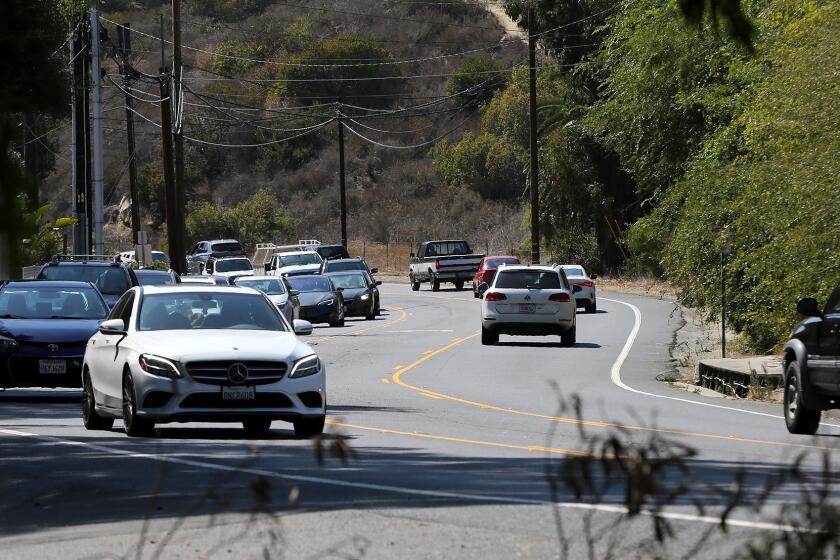Newport considers how to loosen its ‘granny flats’ rules
A new state law to expand the affordable housing stock by making accessory units easier to build is forcing Newport Beach to relax its longtime restrictions on the secondary homes.
Also known as in-law apartments, granny flats, guesthouses or casitas, the secondary units — in planning parlance, an accessory dwelling unit, or ADU — is a small, complete home that is attached or unattached to, or within, a larger single-family home. This can include backyard cottages or apartments built in basements or above garages.
State law previously gave cities wide latitude on local restrictions. As such, Newport Beach generally banned these add-ons, except for people age 55 and older.
But a law enacted earlier this year to reduce barriers to accessory unit development nullifies Newport Beach’s strict limitations, city planner Jaime Murillo told the Planning Commission on Thursday.
The new law allows cities continued discretion on zoning, lot and unit size, and aesthetics. But provided they meet the basic standards, the units would be approved without a public hearing.
City staff proposes lots be at least 5,000 square feet, the minimum for new construction in most single-family zoned areas of the city, Murillo said.
This would generally exclude older parts of town with small lots and chronic parking issues, such as Newport Shores, Bayshores, Balboa Peninsula and Corona del Mar.
Also, the state law does not restrict homeowners associations from prohibiting accessory units within their own regulations.
Almost 19,000 Newport Beach home sites could be eligible to build an accessory unit, city staff said.
Planning Commission Chairman Kory Kramer agreed with the city’s proposed aesthetic, street setback and parking standards, but was cool to the city-proposed lot and interior square footage limits.
“I’m not a huge fan of some of these items,” he said. “From a policy perspective, I’m kind of scratching my head on some of these. For example, on minimum lot size, why would we deviate from the state standard of no standard?”
Murillo said limiting accessory units to lots greater than 5,000 square feet preserves neighborhood character and puts the homes in areas with better parking and privacy.
“The state allows the city to establish those standards,” he said, although they are only staff recommendations that can be changed with commission direction.
Accessory units provide lower-cost options for multi-generational living, live-in caretakers, college students and young families, plus provide an alternative to government-subsidized housing. They also benefit the property owner, who becomes a landlord.
Brenda Wisneski, deputy community development director, said the city has no active applications for accessory units, although one property owner has shown a strong interest. That person’s plans would comply with the suggested new rules, she added.
The commission took no action on Thursday, except to continue the topic to a future meeting. Any new standards would have to be finalized by the City Council.
Kramer said he wants to do more research. Commissioner Bill Dunlap said he was concerned because the item drew little public feedback.
“That really concerns me because it has such an effect on all these different residences … this is almost something that should have a workshop,” he said.
How regulations differ
Location
State: Permitted on lots zoned for both single-family and multifamily residential. Must be on same lot.
Newport Beach: Single-family residential zones only. Prohibited in multifamily and duplex districts.
Lot size (minimum)
State: No standard
Newport Beach: 5,000 square feet or greater.
Unit size (maximum)
State: Attached: 50% of existing living area, with a maximum of 1,200 square feet. Detached: 1,200 square feet.
Newport Beach: 750 square feet or 50% of existing floor area (excluding garage) of the main home, whichever is less.
Aesthetics
State: No standard
Newport Beach: Height: One story, 14 feet (detached); conform to underlying zoning district if attached above garage (typically 24 feet flat roof, 29 feet sloped). Architectural style, roof pitch, color, materials similar to main home.
Setbacks
State: Not required for converted garage. No more than 5 feet from a side or rear lot line for apartment above a garage.
Newport Beach: Per state standard and local zoning code.
Parking
State: Maximum of one space per unit or bedroom, whichever is greater. May be uncovered, tandem on driveway or on mechanical lift. None required if within half-mile of bus stop
Newport Beach: Per state standard, with none allowed in rear alleys.
Fire sprinklers
State: Not required if not required for main home.
Newport Beach: Per state standard.
Source: Newport Beach
Twitter: @Daily_PilotHD
All the latest on Orange County from Orange County.
Get our free TimesOC newsletter.
You may occasionally receive promotional content from the Daily Pilot.




